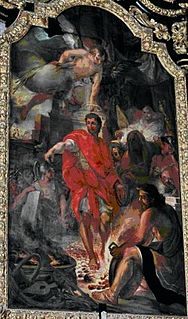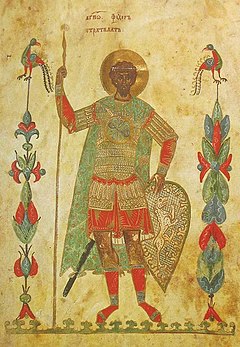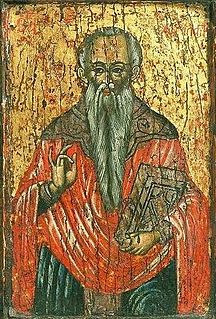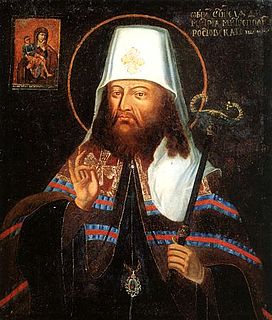
Saint Sebastian was an early Christian saint and martyr. According to traditional belief, he was killed during the Roman emperor Diocletian's persecution of Christians. He is most commonly depicted in art and literature tied to a post or tree and shot with arrows, but this did not kill him. He was, according to his legend, rescued and healed by Saint Irene of Rome, which became a popular subject in 17th-century painting. In all versions of the story, shortly after his recovery he went to Diocletian to warn him about his sins, and as a result was clubbed to death. He is venerated in the Roman Catholic Church and the Orthodox Church.
Saints Theodora and Didymus are Christian saints whose legend is based on a 4th-century acta and the word of Saint Ambrose. The pair were martyred in the reigns of co-ruling Roman Emperors Diocletian and Maximianus.

May 30 - Eastern Orthodox Church calendar - June 1

Saint Pantaleon, counted in the West among the late-medieval Fourteen Holy Helpers and in the East as one of the Holy Unmercenary Healers, was a martyr of Nicomedia in Bithynia during the Diocletianic Persecution of 305 AD.

Saint Quentin also known as Quentin of Amiens, was an early Christian saint. No real details are known of his life.

Yevgeny Aleksandrovich Rodionov was a Russian soldier who was taken prisoner of war by Chechen rebels and later executed in captivity. He has gained much admiration throughout Russia for the circumstances of his death, as his execution allegedly resulted from his refusal to convert to Islam and defect to the enemy side. Despite widespread popular veneration he has not been glorified by the Russian Orthodox Church as a New Martyr due to lack of evidence about his death.

Saint Minas, the Martyr and Wonder-worker, is one of the most well-known Egyptian saints in the East and the West, due to the many miracles that are attributed to his intercession and prayers. Minas was an Egyptian soldier in the Roman army martyred because he refused to recant his Christian faith. The common date of his commemoration is November 11, which occurs 13 days later on the Julian calendar.
Saints Leontius, Hypatius and Theodolus were Roman soldiers who, according to Christian tradition, were martyred for their faith.

Saint Tiburtius, according to Christian legend, was a Christian martyr. His feast day is 11 August which is the same as Saint Susanna. These saints were not related, but are sometimes associated because they are venerated on the same day.

Theodore Stratelates, also known as Theodore of Heraclea, is a martyr and Warrior Saint venerated with the title Great-martyr in the Eastern Orthodox Church, Eastern Catholic and Roman Catholic Churches and Oriental Orthodox Churches.
Saint Dasya the Soldier, was a Christian martyr of the third century. He was born in Tanda, Egypt, and served as a soldier in the Roman army. Refusing to deny Christ, Dasya was tortured by Arianus, governor of Ansena, and his head eventually cut off. His feast in the Coptic Orthodox Church is on 2 Thout.

Charalambos was an early Christian bishop in Magnesia on the Maeander, a region of Asia Minor, in the diocese of the same name. His name Χαράλαμπος means glowing with joy in Greek. He lived during the reign of Septimius Severus (193–211), when Lucian was Proconsul of Magnesia. It is believed that at the time of his martyrdom in 202, Charalambos was 113 years old.
Basilides and Potamiaena were Christian martyrs now venerated as saints. Both died in Alexandria during the persecutions under Septimus Severus.

The 20,000 Martyrs of Nicomedia refers to victims of persecution of Christians in Nicomedia, Bithynia by the Roman Emperors Diocletian and Maximian in the early 4th century AD.

Hripsime, also called Rhipsime, Ripsime, Ripsima or Arsema, was a martyr of Roman origin; she and her companions in martyrdom are venerated as the first Christian martyrs of Armenia.

Saint Sabbas Stratelates, Sabbas the General of Rome — early Christian warrior saint and martyr, was Roman military general under emperor Aurelian. He is the 'twin' of Saint Sabbas the Goth. His martyrdom was followed by 70 Roman soldiers.
Paul and Juliana were brother and sister who suffered martyrdom, at the hands of Aurelian, in 270.

Mercurius was a Christian saint and a martyr. He was born in the city of Eskentos in Cappadocia, in Eastern Asia Minor.
Saint Abanoub or Abanoub Al-Nahisy, is a 4th-century Christian saint and martyr from Egypt. His name means Father of Gold in Coptic. He was born in Nehisa in the Nile Delta to Christian parents. Abanoub was 12 years old when he was killed and beheaded, after being tortured for refusing to leave Christianity. His feast day is July 31. His relics are preserved in St.Virgin Mary and St.Abanoub Churches in Sebennytos, Egypt. His title is often The Child Martyr.
Saint Abaskhiron the Soldier or Saint Eskhayron the Soldier is an Egyptian martyr. The name “Abaskhyron” is derived from two words, “Abba” which means father, is given to him due to respect. The second part of the name, “skhyron,” sometimes “eshseros,” “eskaros” means the strong


















